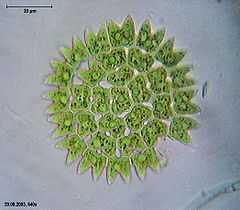Pediastrum
| Pediastrum | |
|---|---|
 | |
| Pediastrum duplex | |
| Scientific classification | |
| Domain: | Eukaryota |
| Kingdom: | Protista |
| Division: | Chlorophyta |
| Class: | Chlorophyceae |
| Order: | Chlorococcales |
| Family: | Hydrodictyaceae |
| Genus: | Pediastrum Meyen, 1829 |
| Type species | |
| Pediastrum duplex | |
| Species[1] | |
| |

Pediastrum is a genus of algae, in the family Hydrodictyaceae.[1] It is a nonmotile coenobial (fixed number of cells) green algae that inhabits freshwater environments.
Reproduction
Pediastrum reproduces asexually by producing autocolonies. The protoplast of each parent cell gives rise to a biflagellate zoospore for each cell in the parent colony. The zoospores are freed from the parent cell within a vesicle and then arrange themselves into the cellular arrangement for that particular species. The cells then enlarge until they reach full size. Each cell can generate a daughter autocolony with exactly the same number and arrangement of cells as the parent colony.
Pediastrum reproduces sexually via the fusion of small, biflagellate gametes that are released from the parent cell. The zygotes germinate into zoospores, which turn into thick-walled polyeders that generate the new coenobia. These polyeders can also result from asexual reproduction.
References
- ↑ 1.0 1.1 Guiry, M.D. & Guiry, G.M. (2007). "Genus: Pediastrum taxonomy browser". AlgaeBase version 4.2 World-wide electronic publication, National University of Ireland, Galway. Retrieved 2007-09-25.
External links
Scientific references
- PubMed references for Pediastrum
- PubMed Central references for Pediastrum
- Google Scholar references for Pediastrum
Scientific databases
- NCBI taxonomy page for Pediastrum
- Search Tree of Life taxonomy pages for Pediastrum
- Search Species2000 page for Pediastrum
- AlgaeBase
- AlgaTerra database
- Index Nominum Genericorum